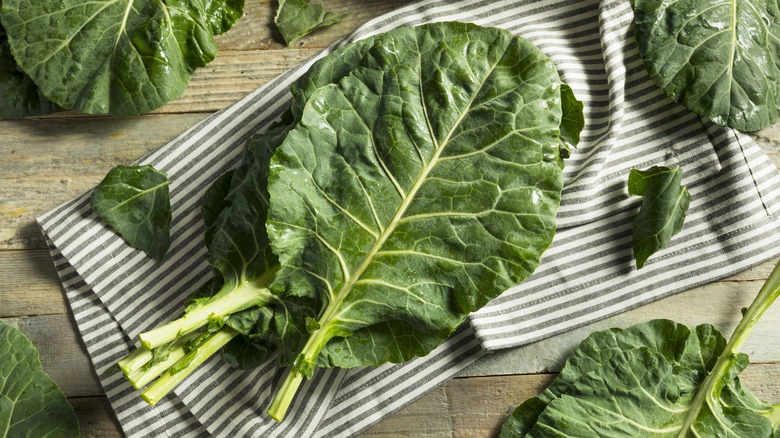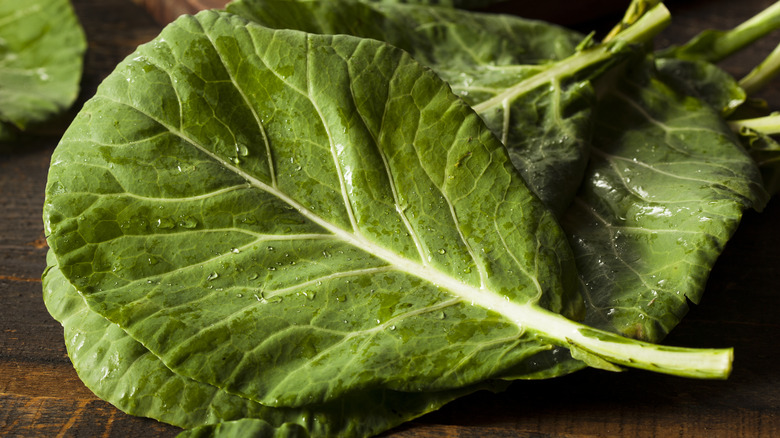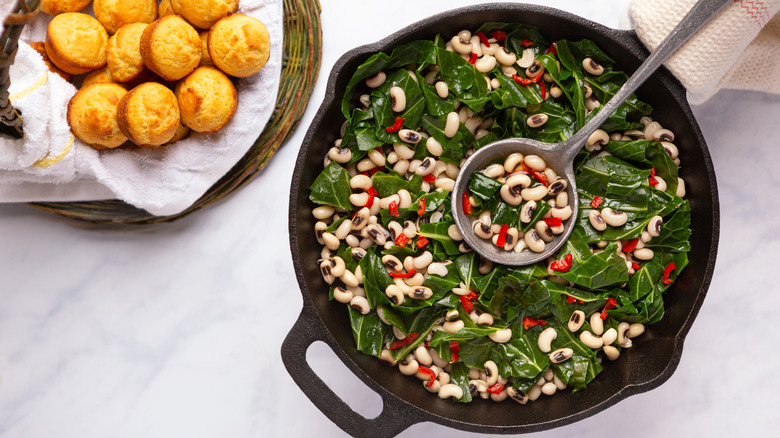The Simple Method To Properly Clean Collard Greens
Delicious, nutritious collard greens have long been a staple of Southern cooking and are perfect for everything from classic braised preparations using leftover ham bone or ham hocks to more inventive dishes such as creamed parmesan collard greens. As a great source of vitamins A, C, and K (128% of the recommended daily value), they are well worth incorporating into your cooking. But this begs the question of just how to go about cleaning these tough-stemmed cruciferous. The large leaves can be a bit unwieldy to handle, and often come from the grocery store or farmers market blanketed in dirt, grit, pesticides, or even insects.
It turns out that the best way to clean collard greens is also the simplest method — just give them a good rinse under running water. While the internet is full of suggestions instructing you to soak greens in a bowl or sink for the purpose of washing them, the CDC advises against this practice (per the CDC). The reason is twofold: Soaking can transfer bacteria among the leaves, and even the cleanest sink can still harbor germs and contaminate your produce.
While the CDC warns that washing cannot remove 100% of germs, rinsing your collard greens is the safest way to clean them. The agency also suggests that proper handling and cooking of leafy greens rather than eating them raw can reduce the risk of foodborne illness.
Safely clean collard greens with plain running water
To clean your collard greens, start with clean hands. It's wise to wash your hands with soap under warm water for 20 seconds before handling produce (via the FDA). Discard any rotten leaves and trim away any small bruised or damaged areas while keeping the leaves whole for washing.
When you're ready to start, take one leaf and hold it under running water while gently rubbing it to remove dirt. Go over it front and back; use your eyes to spot any dirty areas and your hands to feel for any grit. You'll want to wash each leaf individually so that you can inspect each one and make sure each leaf is thoroughly cleaned. Once they look and feel clean, the collards should be dried with a clean paper towel or kitchen cloth, which will also help to keep bacteria at bay.
Government food and health agencies agree that water is all you need to safely clean your greens. Avoid using soap, detergents, or products sold as produce washes — these are not approved for food use by the FDA and can be unsafe if absorbed into the food and eaten (per the USDA). Never use bleach on collard greens or other foods (via the CDC), as it's dangerous if ingested and may cause illness or even death (per PennLive). The only time you can skip washing your collard greens is if they come pre-packaged and labeled "pre-washed" or "ready to eat."
How to cook collards so they don't taste bitter
Once your collard greens are properly cleaned, you're ready to cook. You may wish to remove the thick central rib as it tends to remain tough and fibrous. To do so, you can either fold the leaves in half vertically and gently tear out the stem, or slice down along the inner side to cut it out. To chop the greens into symmetrical ribbons, stack a few on top of each other and roll them up lengthwise. Slice the roll in cuts about the width of your thumb to end up with even strips about an inch wide.
While their taste can be somewhat astringent, there are some tricks for how to cook collard greens to avoid bitter flavors. Longer cooking times help to release some of that bitterness, so a long, slow braise will result in a more mellow flavor. You can also try adding an acid — there's a practical reason these greens are often paired with vinegar, and it's not just because they make a taste combo; vinegar's tartness actually helps to temper the bitterness.
Another tip for toning down bitterness is to add baking soda to your cooking liquids (⅛ to ½ teaspoon per pot of water). Its alkaline qualities balance the collards' pH levels — a surefire way to draw out the harsh notes. Furthermore, the baking soda also helps preserve the vibrant green color of your collard greens, which can otherwise turn brown when cooked.



